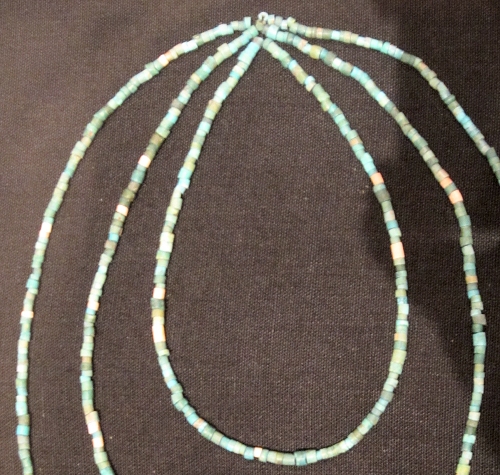There is something awe-inspiring about a scrap of fabric woven 6000 years ago.
I am not a weaver, but I was amazed by the thinness of these hand-spun threads and the use of omitted (or drawn?) threads to create a linear pattern. The exhibit also contains a very rare wooden warp beam for a horizontal loom ( it looked less than 18 inches wide) and a “cylindrical stick for a warp-weighted loom;” both looked very small, but nomadic people have to work with portable looms. These people used both vertical and horizontal looms. I wish there had been more explanation about these:

Warp Beam for Horizontal Ground Loom and Cylindrical Stick for Warp-Weighted Loom. Masters of Fire exhibit.
Masters of Fire Exhibit
I wasn’t expecting to find textiles in an exhibit called Masters of Fire, which is about Late Chalcolithic (Copper Age meets Stone Age) artifacts found in the region now called Israel. “This exhibition is organized by the Institute for the Study of the Ancient World and the Israel Antiquities Authority in collaboration with The Israel Museum, Jerusalem.” The museum website reminds us that this fabric was woven centuries before the Egyptian pyramids were built.
Very Old Sandals

Leather sandals from the Cave of the Warrior, north of Jerusalem, 4500 to 3600 BC. Israel Antiquities Authority.
“This pair of sandals, made of coarse, light-colored cowhide, was found inside the burial shroud of the person interred, placed one inside the other. Sandals were very rare in the Southern Levant until the Roman period. These examples, preserved only due to the dry climate of the Judean desert, provide evidence of the elevated status of the individual buried at the site.”
I wonder if the soles were worn through by the owner, as appears to be the case with the sole of the sandal on top? As in Roman sandals three or four thousand years later, the leather near the heel has slits through which the cords that tie the sandals to the foot can pass. The slits at the toe are harder to make out, but visible. I wonder if that thing that looks like a button was part of the piece that goes between your big toe and the rest of your toes in a flip-flop? And, if there are archeologists 6000 years from now, what will they make of the shoes worn today by people of “elevated status?”
Turquoise Necklace from Ze ‘elim
The fine workmanship on the maces and other metallic objects still didn’t prepare me for these incredibly tiny turquoise beads — remember, copper is a soft metal, not like bronze or iron, so I can’t even imagine how the minuscule holes were drilled! These are not a whole lot bigger than modern glass beads.
“Violin Shaped Figurines”
The exhibit includes many tiny figurines drilled to be used as pendants or trim; the same violin shape is repeated in larger figurines. As I moved from case to case, I got a clearer idea of what these figures represented:

Decorated Violin shaped figurine. She seems to be wearing a skirt. 4500-3600 BC, Eastern Mediterranean. Click to enlarge.
This poor little lady has lost an eye, but I’d rather think of her as winking at us.







Lovely, interesting post. At the British Museum I saw linens from the Egyptian mummies that were perfectly preserved not just in terms of their intactness but also in terms of their colour. The quality of the work was what impressed itself on me. Also I love the winking woman.
Thank you. After re-reading Woman’s Work: The First 20,000 Years, I realized I could watch hand spinning on YouTube — but the amount of labor required to spin and weave anything but the coarsest fabrics still makes my head spin. I suppose there may be a theory that the “winking woman” is male — men also wore skirts in the mideast– but that violin-shaped figure with breasts made me guess it’s female.